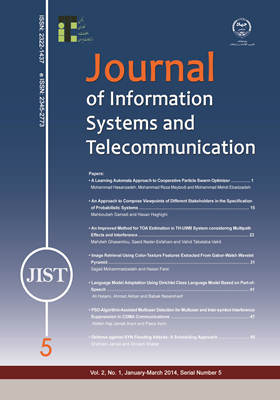An Improved Method for TOA Estimation in TH-UWB System considering Multipath Effects and Interference
محورهای موضوعی : Signal ProcessingMahdieh Ghasemlou 1 , Saeid Nader Esfahani 2 , Vahid Tabataba Vakili 3
1 - Islamic Azad
2 - Tehran
3 - Iran University of Science & Technology
کلید واژه: Threshold, Interference, TOA, Ranging,
چکیده مقاله :
UWB ranging is usually based on the time-of-arrival (TOA) estimation of the first path. There are two major challenges in TOA estimation. One challenge is to deal with multipath channel, especially in indoor environments. The other challenge is the existence of interference from other sources. In this paper, we propose a new method of TOA estimation, which is very robust against the interference. In this method, during the phase of TOA estimation, the transmitter sends its pulses in random positions within the frame. This makes the position of the interference relative to the main pulse to be random. Consequently, the energy of interference would be distributed, almost uniformly, along the frame. In energy detection methodes, a constant interference along the frame does not affect the detection of arrival time and only needs the adjustment of the threshold. Simulation results in IEEE.802.15.4a channels show that, even in presence of very strong interference, TOA estimation error of less than 3 nanoseconds is feasible with the proposed method.
UWB ranging is usually based on the time-of-arrival (TOA) estimation of the first path. There are two major challenges in TOA estimation. One challenge is to deal with multipath channel, especially in indoor environments. The other challenge is the existence of interference from other sources. In this paper, we propose a new method of TOA estimation, which is very robust against the interference. In this method, during the phase of TOA estimation, the transmitter sends its pulses in random positions within the frame. This makes the position of the interference relative to the main pulse to be random. Consequently, the energy of interference would be distributed, almost uniformly, along the frame. In energy detection methodes, a constant interference along the frame does not affect the detection of arrival time and only needs the adjustment of the threshold. Simulation results in IEEE.802.15.4a channels show that, even in presence of very strong interference, TOA estimation error of less than 3 nanoseconds is feasible with the proposed method.


